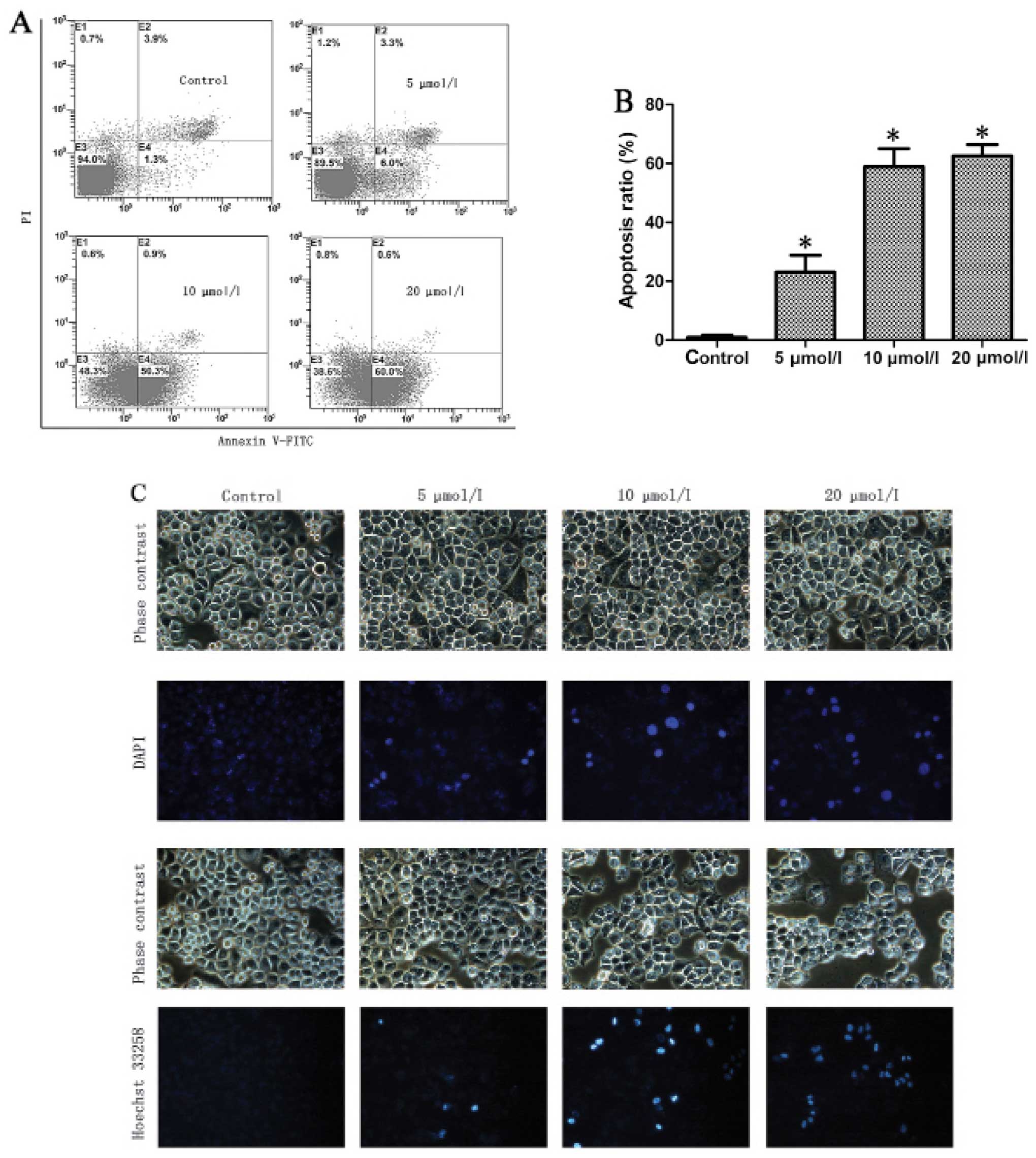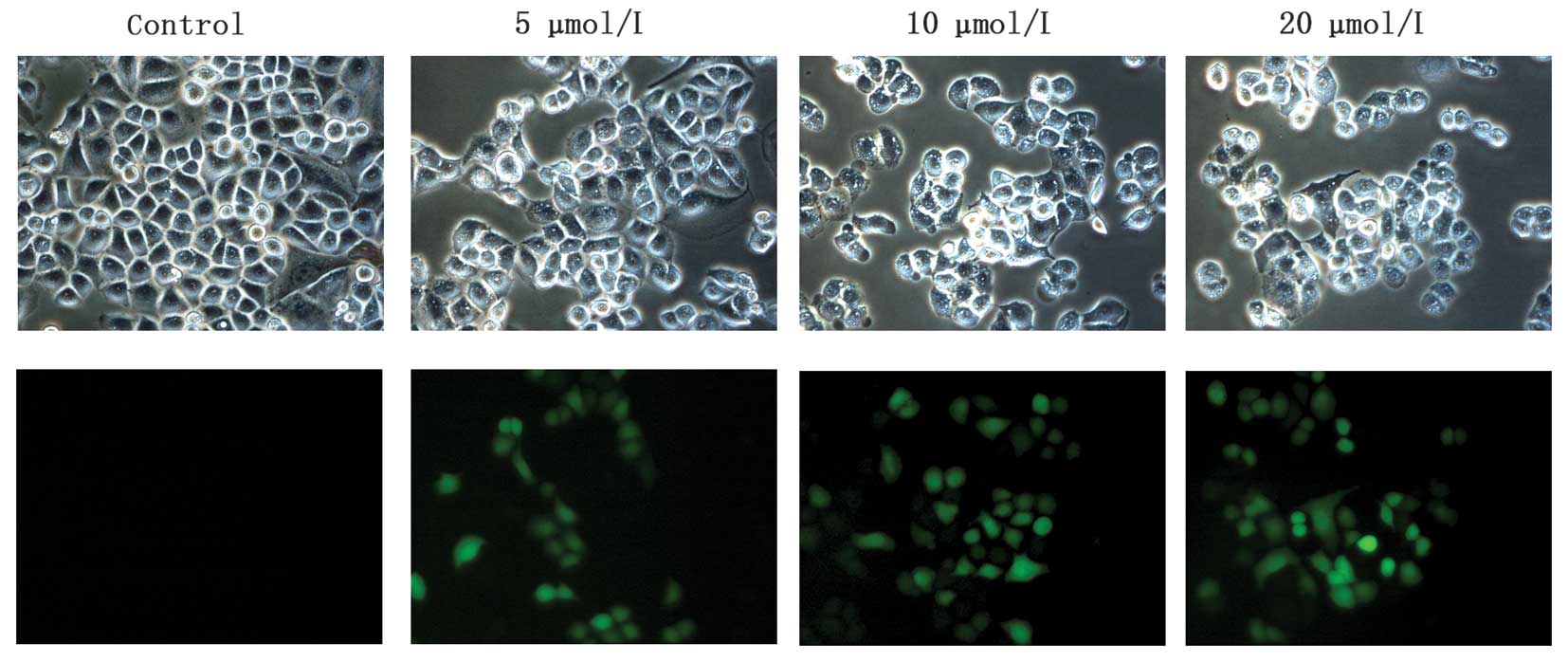|
1
|
Wolf BB and Green DR: Suicidal tendencies:
Apoptotic cell death by caspase family proteinases. J Biol Chem.
274:20049–20052. 1999. View Article : Google Scholar : PubMed/NCBI
|
|
2
|
Susin SA, Daugas E, Ravagnan L, Samejima
K, Zamzami N, Loeffler M, Costantini P, Ferri KF, Irinopoulou T,
Prévost MC, et al: Two distinct pathways leading to nuclear
apoptosis. J Exp Med. 192:571–580. 2000. View Article : Google Scholar : PubMed/NCBI
|
|
3
|
Elrod HA and Sun SY: Modulation of death
receptors by cancer therapeutic agents. Cancer Biol Ther.
7:163–173. 2008. View Article : Google Scholar
|
|
4
|
Kim BG, Kwon HY, Sohn EJ, Hwang S, Kwon OS
and Kim SH: Activation of caspases and inhibition of ribosome
biogenesis mediate antitumor activity of Chijongdan in A549
non-small lung cancer cells. BMC Complement Altern Med. 14:4202014.
View Article : Google Scholar : PubMed/NCBI
|
|
5
|
Zorofchian Moghadamtousi S, Karimian H,
Rouhollahi E, Paydar M, Fadaeinasab M and Abdul Kadir H: Annona
muricata leaves induce G1 cell cycle arrest and
apoptosis through mitochondria-mediated pathway in human HCT-116
and HT-29 colon cancer cells. J Ethnopharmacol. 156:277–289. 2014.
View Article : Google Scholar : PubMed/NCBI
|
|
6
|
Qu L, Liu FX, Cao XC, Xiao Q, Yang X and
Ren KQ: Activation of the apoptosis signal-regulating kinase
1/c-Jun N-terminal kinase pathway is involved in the
casticin-induced apoptosis of colon cancer cells. Exp Ther Med.
8:1494–1500. 2014.PubMed/NCBI
|
|
7
|
Chen Y, Mo HZ, Hu LB, Li YQ, Chen J and
Yang LF: The endogenous nitric oxide mediates selenium-induced
phytotoxicity by promoting ROS generation in Brassica rapa. PLoS
One. 9:e1109012014. View Article : Google Scholar : PubMed/NCBI
|
|
8
|
Li Z, Meng J, Xu TJ, Qin XY and Zhou XD:
Sodium selenite induces apoptosis in colon cancer cells via
Bax-dependent mitochondrial pathway. Eur Rev Med Pharmacol Sci.
17:2166–2171. 2013.PubMed/NCBI
|
|
9
|
Li XL, Wong YS, Xu G and Chan JC:
Selenium-enriched Spirulina protects INS-1E pancreatic beta cells
from human islet amyloid polypeptide-induced apoptosis through
suppression of ROS-mediated mitochondrial dysfunction and PI3/AKT
pathway. Eur J Nutr. Aug 12–2014.(Epub ahead of print).
|
|
10
|
Sarveswaran S, Liroff J, Zhou Z, Nikitin
AY and Ghosh J: Selenite triggers rapid transcriptional activation
of p53, and p53-mediated apoptosis in prostate cancer cells:
Implication for the treatment of early-stage prostate cancer. Int J
Oncol. 36:1419–1428. 2010.PubMed/NCBI
|
|
11
|
Huang F, Huang J, Lv Q, Yang Y, Wu G and
Xu C: Selenite induces apoptosis in colorectal cancer cells through
interaction with thioredoxin reductase. BMB Rep. pii: 2370.
2013.
|
|
12
|
Cherukuri DP and Nelson MA: Role of
reactive oxygen species (ROS) and JNKs in selenite-induced
apoptosis in HepG2 cells. Cancer Biol Ther. 7:697–698. 2008.
View Article : Google Scholar : PubMed/NCBI
|
|
13
|
Chen XJ, Duan FD, Zhang HH, Xiong Y and
Wang J: Sodium selenite-induced apoptosis mediated by ROS attack in
human osteosarcoma U2OS cells. Biol Trace Elem Res. 145:1–9. 2012.
View Article : Google Scholar
|
|
14
|
Huang F, Nie C, Yang Y, Yue W, Ren Y,
Shang Y, Wang X, Jin H, Xu C and Chen Q: Selenite induces
redox-dependent Bax activation and apoptosis in colorectal cancer
cells. Free Radic Biol Med. 46:1186–1196. 2009. View Article : Google Scholar : PubMed/NCBI
|
|
15
|
Zhang W, Xiao H and Parkin KL: Apoptosis
in MCF-7 breast cancer cells induced by S-alkenylmercaptocysteine
(CySSR) species derived from Allium tissues in combination with
sodium selenite. Food Chem Toxicol. 68:1–10. 2014. View Article : Google Scholar : PubMed/NCBI
|
|
16
|
Wu S, Bao Y, Ma D, Zi Y, Yang C, Yang M,
Xing M and Yang W: Sodium selenite inhibits leukemia HL-60 cell
proliferation and induces cell apoptosis by enhancing the
phosphorylation of JNK1 and increasing the expression of p21 and
p27. Int J Mol Med. 34:1175–1179. 2014.PubMed/NCBI
|
|
17
|
Suzuki M, Endo M, Shinohara F, Echigo S
and Rikiishi H: Rapamycin suppresses ROS-dependent apoptosis caused
by selenomethionine in A549 lung carcinoma cells. Cancer Chemother
Pharmacol. 67:1129–1136. 2011. View Article : Google Scholar
|
|
18
|
Shi X, Jin Y, Cheng C, Zhang H, Zou W,
Zheng Q, Lu Z, Chen Q, Lai Y and Pan J: Triptolide inhibits Bcr-Abl
transcription and induces apoptosis in STI571-resistant chronic
myelogenous leukemia cells harboring T315I mutation. Clin Cancer
Res. 15:1686–1697. 2009. View Article : Google Scholar : PubMed/NCBI
|
|
19
|
Oltvai ZN, Milliman CL and Korsmeyer SJ:
Bcl-2 heterodimerizes in vivo with a conserved homolog, Bax, that
accelerates programmed cell death. Cell. 74:609–619. 1993.
View Article : Google Scholar : PubMed/NCBI
|
|
20
|
Kitamura Y, Shimohama S, Kamoshima W, Ota
T, Matsuoka Y, Nomura Y, Smith MA, Perry G, Whitehouse PJ and
Taniguchi T: Alteration of proteins regulating apoptosis, Bcl-2,
Bcl-x, Bax, Bak, Bad, ICH-1 and CPP32, in Alzheimer’s disease.
Brain Res. 780:260–269. 1998. View Article : Google Scholar : PubMed/NCBI
|
|
21
|
Hockenbery D, Nuñez G, Milliman C,
Schreiber RD and Korsmeyer SJ: Bcl-2 is an inner mitochondrial
membrane protein that blocks programmed cell death. Nature.
348:334–336. 1990. View Article : Google Scholar : PubMed/NCBI
|
|
22
|
Gross A, McDonnell JM and Korsmeyer SJ:
BCL-2 family members and the mitochondria in apoptosis. Genes Dev.
13:1899–1911. 1999. View Article : Google Scholar : PubMed/NCBI
|
|
23
|
Ma Q, Fang H, Shang W, Liu L, Xu Z, Ye T,
Wang X, Zheng M, Chen Q and Cheng H: Superoxide flashes: Early
mitochondrial signals for oxidative stress-induced apoptosis. J
Biol Chem. 286:27573–27581. 2011. View Article : Google Scholar : PubMed/NCBI
|
|
24
|
Said RS, Badr AM, Nada AS and El-Demerdash
E: Sodium selenite treatment restores long-lasting ovarian damage
induced by irradiation in rats: Impact on oxidative stress and
apoptosis. Reprod Toxicol. 43:85–93. 2014. View Article : Google Scholar
|
|
25
|
Weekley CM, Jeong G, Tierney ME, Hossain
F, Maw AM, Shanu A, Harris HH and Witting PK: Selenite-mediated
production of superoxide radical anions in A549 cancer cells is
accompanied by a selective increase in SOD1 concentration, enhanced
apoptosis and Se-Cu bonding. J Biol Inorg Chem. 19:813–828. 2014.
View Article : Google Scholar : PubMed/NCBI
|
|
26
|
Yang GQ and Gu LZ: The requirements and
acceptable daily intake of trace element selenium in human body.
Prog Physiol Sci. 23:184–186. 1992.
|
|
27
|
Guan L, Han B, Li J, Li Z, Huang F, Yang Y
and Xu C: Exposure of human leukemia NB4 cells to increasing
concentrations of selenite switches the signaling from pro-survival
to pro-apoptosis. Ann Hematol. 88:733–742. 2009. View Article : Google Scholar : PubMed/NCBI
|
|
28
|
Li Z, Shi K, Guan L, Cao T, Jiang Q, Yang
Y and Xu C: ROS leads to MnSOD upregulation through ERK2
translocation and p53 activation in selenite-induced apoptosis of
NB4 cells. FEBS Lett. 584:2291–2297. 2010. View Article : Google Scholar : PubMed/NCBI
|
|
29
|
Guan L, Han B, Li Z, Hua F, Huang F, Wei
W, Yang Y and Xu C: Sodium selenite induces apoptosis by
ROS-mediated endoplasmic reticulum stress and mitochondrial
dysfunction in human acute promyelocytic leukemia NB4 cells.
Apoptosis. 14:218–225. 2009. View Article : Google Scholar : PubMed/NCBI
|
|
30
|
Mi L, Xiao Z, Hood BL, Dakshanamurthy S,
Wang X, Govind S, Conrads TP, Veenstra TD and Chung FL: Covalent
binding to tubulin by isothiocyanates. A mechanism of cell growth
arrest and apoptosis. J Biol Chem. 283:22136–22146. 2008.
View Article : Google Scholar : PubMed/NCBI
|
|
31
|
Jiang Q, Wang Y, Li T, Shi K, Li Z, Ma Y,
Li F, Luo H, Yang Y and Xu C: Heat shock protein 90-mediated
inactivation of nuclear factor-κB switches autophagy to apoptosis
through BECN1 transcriptional inhibition in selenite-induced NB4
cells. Mol Biol Cell. 22:1167–1180. 2011. View Article : Google Scholar : PubMed/NCBI
|
|
32
|
Wang HY and Ou BX: Experimental study on
selenium preventing nasopharyngeal carcinoma. Zhonghua Yu Fang Yi
Xue Za Zhi. 26:281–283. 1992.(In Chinese). PubMed/NCBI
|
|
33
|
Park JS, Ryu JY, Jeon HK, Cho YJ, Park YA,
Choi JJ, Lee JW, Kim BG and Bae DS: The effects of selenium on
tumor growth in epithelial ovarian carcinoma. J Gynecol Oncol.
23:190–196. 2012. View Article : Google Scholar : PubMed/NCBI
|
|
34
|
Park SH, Kim JH, Chi GY, Kim GY, Chang YC,
Moon SK, Nam SW, Kim WJ, Yoo YH and Choi YH: Induction of apoptosis
and autophagy by sodium selenite in A549 human lung carcinoma cells
through generation of reactive oxygen species. Toxicol Lett.
212:252–261. 2012. View Article : Google Scholar : PubMed/NCBI
|
|
35
|
Králová V, Benešová S, Cervinka M and
Rudolf E: Selenite-induced apoptosis and autophagy in colon cancer
cells. Toxicol In Vitro. 26:258–268. 2012. View Article : Google Scholar
|
|
36
|
Sharma G, Park J, Sharma AR, Jung JS, Kim
H, Chakraborty C, Song DK, Lee SS and Nam JS: Methoxy
poly(ethyleneglycol)-poly(lactide) nanoparticles encapsulating
quercetin act as an effective anticancer agent by inducing
apoptosis in breast cancer. Pharm Res. 32:723–735. 2015. View Article : Google Scholar
|
















